John Deere 1705 Twin Row Planter
Mounted Planters
Your Preferred Location
Features
-
Row Unit: MaxEmerge 5
-
Number of Rows: 6 twin rows
-
Transport Width: 13 ft. 3 in., 16 ft. 4 in., 23 ft. 1 in., 28 ft. 10 in.
-
Spacing (inches): 36-in (91-cm) or 38-in (96-cm) spacing
-
Central Commodity System (CCS): N/A
Specifications
Additional Information - Recommended tractor hydraulics: |
Hydraulic oil required to operate the planter: 5.7 L 1.5 gal. Hydraulic system working pressure: 20,684 kPa 207 bar (3000 psi) Hydraulic system burst pressure: 82,737 kPa 827 bar (12,000 psi) |
Closing System - Cast iron closing system: |
|
Closing System - Rubber tire closing system: |
|
Dimensions - Transport height: |
2.4 m 8 ft |
Dimensions - Transport width (with markers): |
5.9 m 19.25 in. |
Drive System - Base: |
Ground driven or hydraulic driven |
Fertilizer - Dry fertilizer: |
|
Fertilizer - Fertilizer opener type: |
|
Frame - Flexibility: |
None |
Frame - Fold configuration: |
Figid |
Key Specs - Frame - Flexibility: |
None |
Key Specs - Frame - Fold configuration: |
Rigid |
Key Specs - Number of rows: |
6 twin rows |
Key Specs - Row spacing: |
91 or 96 cm 36 or 38 in. |
Key Specs - Row unit seed hoppers: |
Capacity 58 or 106 L 1.6 or 3 bu |
Key Specs - Seed Meters: |
Base Vacuum |
Lift System - Type: |
Integral or Semi-integral |
Markers - Control: |
|
Markers - Marker disk: |
|
Markers - Type: |
Automatic alternating or independent control |
Row Units - Opener: |
Tru-Vee Double Disk |
Row Units - Row unit down force: |
|
Row Units - Row unit seed hoppers: |
Capacity 58 or 106 L 1.6 or 3 bu |
Row Units - Scrapers, opener blades: |
|
Row Units - Seed tube sensors: |
Optional -- |
Row Units - Type: |
MaxEmerge™ 5 row unit |
Rows and Row Spacing - Number of rows: |
6 twin rows |
Rows and Row Spacing - Row spacing: |
91 or 96 cm 36 or 38 in. |
Seed Meters - Base: |
Vacuum |
Seed Meters - Central Commodity System: |
|
Tires - Base: |
7.60-15 6 Ply - Traction: 280 kPa 2.8 bar (40 psi) 7.60-15 8 Ply - Traction: 359 kPa 3.6 bar (52 psi) |
Seed variable-rate drive provides the ultimate planting productivity
Seed variable-rate drive provides the ultimate planting productivity by utilizing one, two, or three hydraulic motors (varies by model) to turn the seeding drive shaft. Hydraulic control of the seeding drive allows for on-the-go seeding rate changes right from the display mounted inside the tractor cab. Combine this seeding flexibility with the map-based planting option, and seeding rates adjust automatically based on the prescribed map.
Variable-rate drive offers the following advantages over common, ground, or contact-tire drive systems:
-
Rate changes are almost instantaneous; no ramp up or ramp down of system as in some competitive systems
- Permits the producer to match seed population based on different soil types or irrigation practices
- John Deere design provides added operator safety by eliminating any possible drive creep found in some competitive variable-rate drive systems
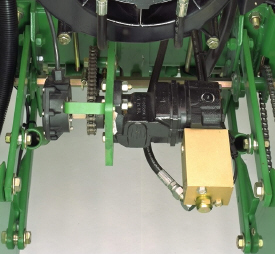 1755 equipped with variable-rate drive
1755 equipped with variable-rate drive
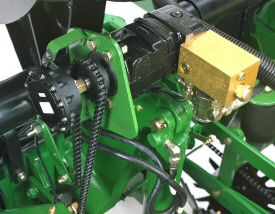 1765NT equipped with variable-rate drive
1765NT equipped with variable-rate drive
Single- or dual-motor systems for variable-rate drives are available for all John Deere planters except the 1785 Rigid Frame. Variable-rate drive is available as a factory-installed option for all applicable planter models.
Single- or dual-motor systems are available as field-installed attachments for most planter models; however, a three-motor variable-rate drive field-installed attachment is not available.
Seed variable-rate drive requires the SeedStar™ monitor and a radar input signal. Either tractor or planter radar may be used. Planter radar is ordered separately.
NOTE: Peanut seed meter disks require the variable-drive transmission.
1705T downforce options
Pneumatic downforce springs
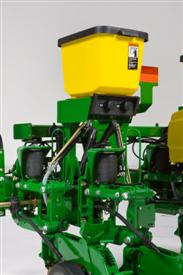 Pneumatic downforce system
Pneumatic downforce system

Pneumatic downforce provides convenient, simple adjustment of downforce for the whole planter from one location. The amount of downforce applied is infinitely adjustable from 0 kg to 181.4 kg (0 lb to 400 lb). Pneumatic downforce provides more consistent downforce throughout the range of row-unit travel than mechanical-spring downforce systems. Each row-unit has a single rubber air bag located between the parallel arms. The air bags are hooked in parallel so that air can be added or released from all rows at once from one location.
Pneumatic downforce systems are available as base equipment on all 1705 Series and DB Planters.
Pneumatic downforce with spring upforce kit
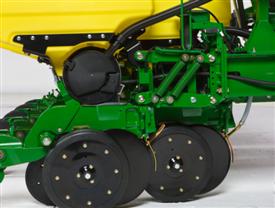 Pneumatic downforce with spring upforce kit
Pneumatic downforce with spring upforce kit
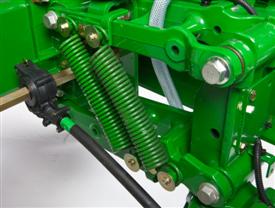 Spring upforce kit
Spring upforce kit
Pneumatic downforce with spring upforce kit option includes the same convenient, simple adjustment of downforce with up to 81.6 kg (180 lb) of upforce per row-unit. Dual upforce springs provide the row-unit upforce to increase flotation in softer soils. This upforce can also be used to counteract excess row-unit margin or extra weight cause by seed, tillage, or other attachments on the row-unit. Upforce springs will limit the maximum amount of downforce that can be placed on a row-unit by the downforce system and should only be used in conditions were adequate and consistent depth control is easily maintained.
SeedStar™ 2 monitoring system gives integrated innovation
Integrated innovation is what operators will appreciate with the SeedStar 2 monitoring system and GreenStar™ 2 Display. An increasing number of acres combined with rising seed costs drive the need to easily understand planter functions and monitor performance. It is all about making every seed count and that is what SeedStar 2 delivers.
The SeedStar 2 monitoring system is a full-feature, color, seed population monitor used in conjunction with the GreenStar family of displays. SeedStar 2 is compatible with the GreenStar 2 1800 and 2600 Displays, GreenStar 3 2630 Display, the Gen 4 4200 CommandCenter™ Display, the Gen 4 4600 CommandCenter Display, the 4240 Universal Display, and the 4640 Universal Display. SeedStar 2 is not compatible with the Gen 4 Extended Monitor. Conveniently, SeedStar 2 planting functions are fully integrated with the full spectrum of Precision Ag Technology applications—guidance, coverage maps, and field documentation can be shown all on one display.
When a SeedStar 2 system is used on a planter, there is no need for a ComputerTrak™ monitor. All vital planting information is displayed in one central, easy-to-read location.
SeedStar 2 features
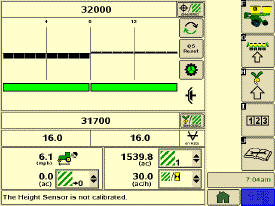 SeedStar 2 full-screen planter run page
SeedStar 2 full-screen planter run page
SeedStar 2 is a user-friendly system that has retained all the valued features of SeedStar and incorporated the next generation of enhancements. For example, on-screen color indicators show drive engagement/disengagement status. In addition, three color planter-at-a-glance bars (black, orange, or red) visually inform the operator of row population status.
Not only does SeedStar 2 incorporate the use of color, it also utilizes an intuitive icon and folder based operator interface. Icons are easy to understand across many languages and reduce the need for text. Icons for planter main run page, planter setup, seed/crop setup, totals, and diagnostics are located in the soft-key region of the display. Setup is performed by selecting the appropriate icon and then choosing the tabs to enter/select information.
The SeedStar 2 monitor offers all the features and functionality of the ComputerTrak 350 monitor and much more. SeedStar 2 monitors the following planter functions:
- Row population/spacing
- Row failure
- Average population (entire planter and by variable-rate drive [VRD] motor section)
- Vacuum level
- Fertilizer pressure
- Acre counter
- Total acreage
- Tractor speed
In addition, planter operational information is available within the SeedStar 2 monitor system. Such operational information includes population charts, seed disk vacuum settings, and setting recommendations for the piston pump liquid fertilizer system.
All SeedStar 2 systems have the capability, through a single controller, to perform both the seed monitoring and variable rate drive functions. SeedStar 2 monitoring is required for VRD population control. Even though the planter may not be equipped with SeedStar 2 VRD, the SeedStar 2 monitoring system is available and will allow for future installation of VRD.
Seedstar 2 is compatible with the RowCommand™ system and Section Control
SeedStar 2 enhancements
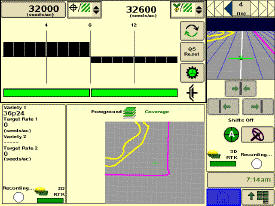 SeedStar 2 half-screen planter run page
SeedStar 2 half-screen planter run page
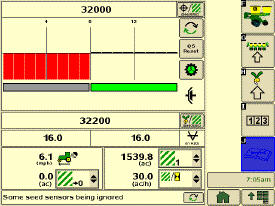 SeedStar 2 showing half-width disconnect status
SeedStar 2 showing half-width disconnect status
The SeedStar 2 enhanced planter features include:
- GreenStar 2 display integration – eliminates the need to operate the GreenStar 2 2600 Display in the original GreenStar monitor mode or the use of dual displays.
- User-friendly, intuitive icons
- Half- or full-screen run page
- On-screen, color drive status – a quick glance at the display tells the operator if the half-width disconnect is engaged or disengaged.
- Three-color planter-at-a-glance population bar – a black bar indicates that population is close to target and within established limits; orange shows the population is above/below the alarm set point; and red signals the population is out of operating range or is not planting.
- Three-piece, color VRD indicator – each piece of the VRD gear pie turns green when the wheel motion sensor is active, planter is lowered, and drives are engaged.
SeedStar monitoring original features
SeedStar 2 retains all those SeedStar features that producers value and have come to expect:
-
Planter at a glance – allows operator to view relative population levels of all rows on one screen.
-
Automatic valve calibration – with the SeedStar VRD, this is now completed automatically. There is no longer a need to manually calibrate the hydraulic valves.
-
Increased population updates – SeedStar will now update population levels once a second at planter start up then approximately once every three seconds.
-
Mapping of actual seed rates – When combined with Field Doc™ system, actual and target seeding rates can now be mapped in APEX™ software.
-
Reprogrammable utilizing controller area network (CAN) via Service ADVISOR™ diagnostics system.
-
Improved diagnostics/event recorder – on SeedStar VRD planters, additional diagnostic information is available, as well as an event recorder to capture system performance data at a specific point in time.
-
Ability to run motors at different population levels – on SeedStar VRD, operators running multiple motor systems can run each motor at a different speed, allowing different population levels within a planter.
-
User-configurable high fertilizer pressure alarm – allows the operator to be warned when fertilizer pressure reaches a specific level.
-
Automatic quick-start for SeedStar VRD – the operator no longer needs to press the quick-start button on end row turns to resume planting.
-
Automatic tractor speed source selection – when equipped with an 8000/9000 Series Tractor, the system selects the radar speed or allows for manual speed input selection.
John Deere Connected Support™ prevents downtime and efficiently resolves issues with revolutionary technology-based solutions
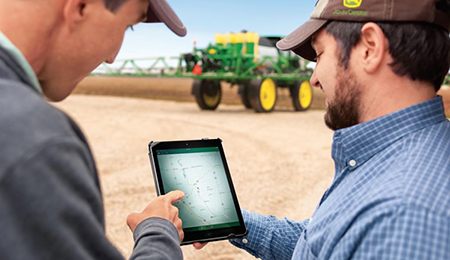 Connected Support technology
Connected Support technology
When you buy John Deere equipment, you expect reliability. You also know that problems can happen, and a product is only as good as the support behind it. That’s why John Deere equipment is prepared with technology that senses potential issues and can alert you and your dealer promptly—in the cab or anywhere you are.
John Deere Connected Support is a revolutionary change to support that leverages technology and the connectivity of JDLink™ telematics to prevent downtime and resolve problems faster. These tools decrease downtime by an average of 20 percent, enabling faster responses to unexpected problems and reducing technician trips to your machine. For some issues, unplanned downtime can even be prevented altogether through prediction of the issue.
With your permission, John Deere Connected Support:
- Keeps you running by monitoring machine health and promptly alerting you and your dealer of issues
- Saves time by remotely viewing in-cab displays, reducing trips to the machine
- Reduces or even eliminates technician trips to a machine through remote diagnostic and remote software reprogramming capabilities
- Connects experts with the information needed to respond to downtime faster and prevent it altogether
With more than a decade of experience leveraging connectivity to solve problems, no one else has the experience, tools, and knowledge to keep you running as John Deere and your John Deere dealer can. Connected Support is an in-base feature on all John Deere products with factory- or field-installed JDLink.
Vacuum system
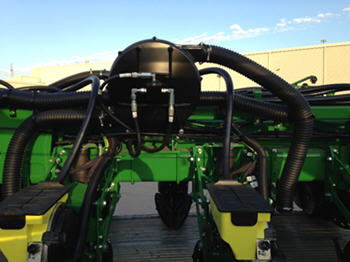 Vacuum system
Vacuum system
Vacuum blower assembly
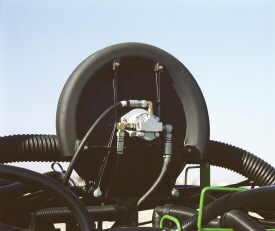 Vacuum blower shown on 1795
Vacuum blower shown on 1795

Vacuum is created by a hydraulically driven vacuum blower assembly mounted on the planter frame. The vacuum blower requires a tractor with a closed-center hydraulic system and a separate selective control valve (SCV). For tractors with open-center hydraulic system, a vacuum 540-rpm or 1000-rpm power take-off (PTO) driven hydraulic pump system is available. PTO pumps offered from the factory are limited to 15-row applications or less.
Different vacuum levels are required depending on the crop being planted. A hydraulic control valve lets the operator regulate vacuum blower speed, changing the vacuum level. On late-model John Deere tractors, vacuum levels are set from the tractor seat using the SCV controls. The control valve is not needed in those applications. At full flow, the system flows up to 18.9 L/min (5 gpm) per motor.
Convenient vacuum gauges located on the planter hitch give a visual indication of the vacuum level. When using a SeedStar™ monitor, the vacuum level can be displayed on the monitor. Consult the vacuum metering seed charts in the operator's manual for initial vacuum setting recommendations.
Vacuum meter case drain
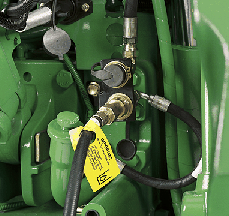 Case drain coupler 7000 Series Tractor
Case drain coupler 7000 Series Tractor

All planters with vacuum metering systems have case drain motors on the vacuum blowers. Case drain lines will have a flush-face case drain coupler on the planter and will require a corresponding flush-face case drain coupler on the tractor. The flush-face coupler simplifies implement attachment by allowing operators to easily identify the case drain. The unique hose tip is unable to connect to another coupler on the tractor, ensuring the correct setup.
It is important to connect this case drain hose to prevent the continuous and complete draining of hydraulic fluid due to the relief feature that opens the coupler when the pressure reaches 68.9 kPa (10 psi). This relief feature is designed to protect the motor shaft seal if for any reason the case drain hose was not connected to the tractor. The flush-face hose tips have less back pressure than ISO case drain tips, and the flat surface makes these couplers easy to clean, providing less chance for contamination.
The case drain line is also used with all Central Commodity System (CCS™) fan motors.


